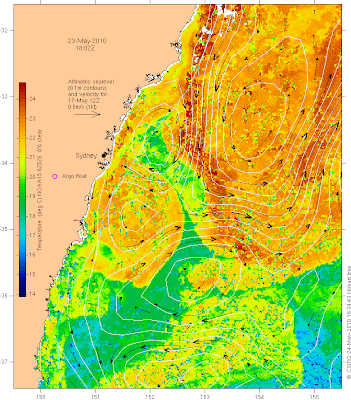The CSIRO has published the following commentary on Sydney's sea surface temperature and currents:
May 18, 2010 - update on Sydney:
Beach water temperatures are still extremely high but the East Australian Current has now started to flow mostly away from the continental shelf at the latitude of Sydney, rather than towards the coast (as it has since late April), triggering the beginning of the end of the high temperatures.
The explanation is faily complex:
Between Sydney and Newcastle a clockwise-rotating, cold-core eddy has now become well established inshore of the EAC. Until the last few days, the EAC was flowing south around this cold-core eddy, feeding into a large pool of EAC water that is warmer than is normally seen off southern NSW at this time of year. The cold-core eddy has now grown so large that very little of the EAC is continuing south: most appears to be flowing offshore at the critical junction point at 34.5S, 152.5E. To complete this eddy-shedding process, the cold-core eddy off Newcastle is likely to merge with the larger cold-core eddy to the SE, thereby completely separating the two masses of warm EAC water: the parent body to the NE, and the newly-shed body to the south.
May 19, 2010 Update:
The eddy shedding is now complete.
Image from CSIRO
Paddling out through the Heads and into the last of the warm sea water for this season.
A Bonito tuna leaps aboard while, in the background, the saturated clouds of moisture forming over the "hot" sea current release some of their water back into the sea ...
... and onto the land.
At its edges the sea's motion is visible in crashing waves along the coastline. But it's the larger "un-seen" drama of massive tumbling vortexes of water moving around offshore that affects our local conditions so profoundly. With the conveyor belt of hot energy that is the EAC now declining in its capacity to push southward at the end of this year's annual cycle we will soon feel cold water on our paddling finger tips and soon see the stream of migrating whales, soaring albatross and curious seals of winter.






























